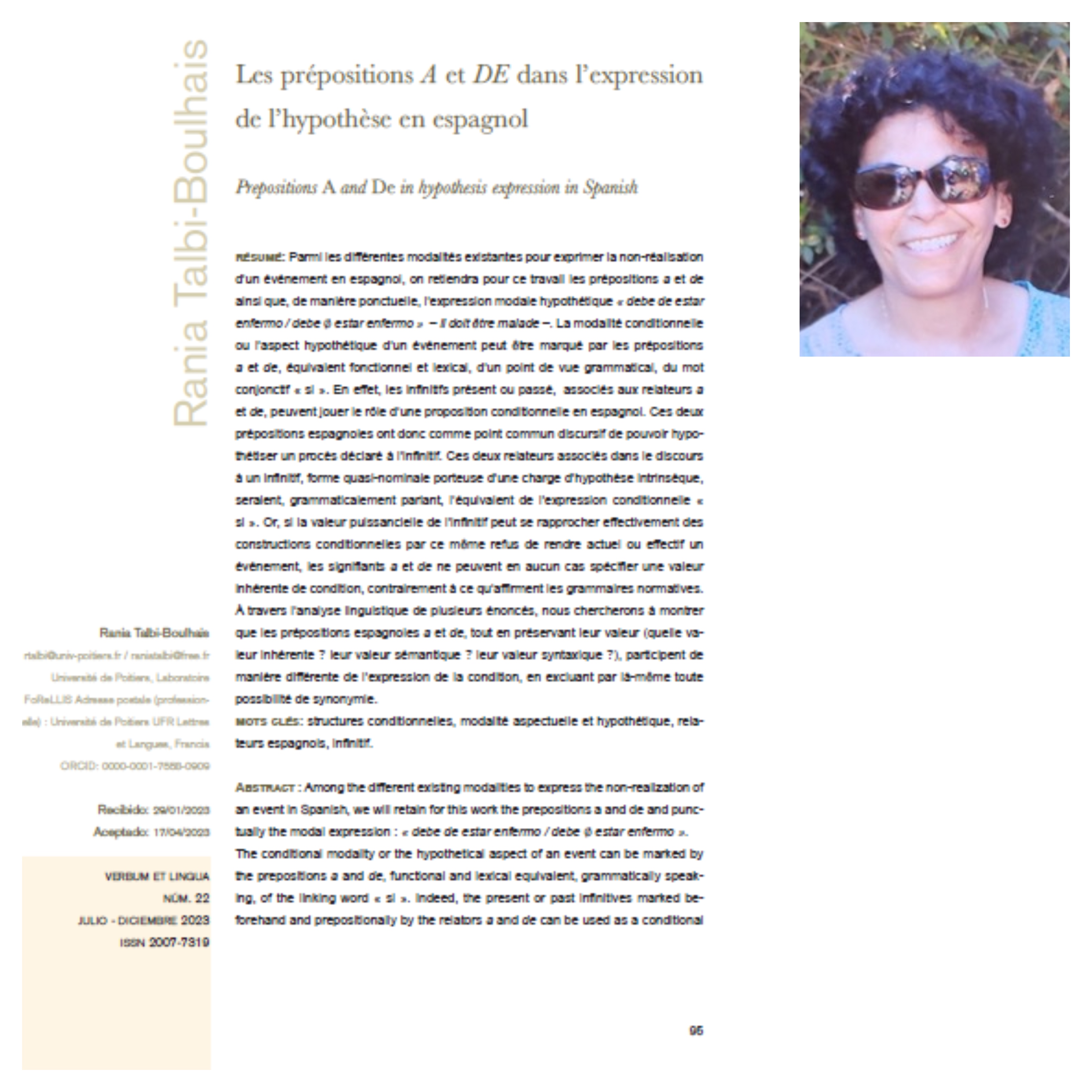Prepositions A and De in hypothesis expression in Spanish
DOI:
https://doi.org/10.32870/vel.vi22.212Keywords:
conditional constructions, aspectual and hypothetical modals, Spanish prepositions, infinitive formAbstract
Among the different existing modalities to express the non-realization of an event in Spanish, we will retain for this work the prepositions a and de and punctually the modal expression : « debe de estar enfermo / debe ? estar enfermo ».
The conditional modality or the hypothetical aspect of an event can be marked by the prepositions a and de, functional and lexical equivalent, grammatically speaking, of the linking word « si ». Indeed, the present or past infinitives marked beforehand and prepositionally by the relators a and de can be used as a conditional clause in Spanish. Therefore, these two Spanish prepositions have the discursive common point of being able to turn a trial declared in the infinitive form into a hypothesis. These two prepositions associated with a verb at its infinitive form in a speech — an almost nominal form carrying an intrinsic load of hypothesis — would be, grammatically speaking, the equivalent of the conditional expression « si ». Now, if the power value of the infinitive can really approach conditional constructions by this same way of refusal to make an event actual or effective, the signifiers a and de can never specify an inherent value of condition, contrary to what assert the normative grammars. This is what we will try to demonstrate, helped by the linguistic analysis of several statements where the Spanish prepositions a and de, while their value remain the same, participate differently in expressing a condition, thus excluding any synonymy.
Downloads
Metrics
References
BEDEL J.-M. (2019). Nouvelle grammaire de l'espagnol moderne. Paris: Presses Universitaires de France.
BÉNABEN M. (1993). Manuel de linguistique espagnole. Paris: Ophrys.
COSTE J., REDONDO A. (1987). Syntaxe de l'espagnol moderne. Paris: S.E.D.E.S.
ECO U. (2006). Dire presque la même chose : Expériences de traduction. Paris: Grasset & Fasquelle.
GERBOIN P., LEROY C. (1997). Grammaire d'usage de l'espagnol contemporain. Paris: Hachette-Éducation.
GUILLAUME G. (1971). Leçons de linguistique de Gustave Guillaume 1948-1949, série B, Psycho-systématique du langage. Principes, méthodes et applications I. 2, Grammaire particulière du français et grammaire générale (IV. Publiées par R. VALIN. Québec-PARIS: PUL — Klincksieck.
GUILLAUME G. (1973). Leçons de linguistique de Gustave Guillaume 1948-1949, série C. 3, Grammaire particulière du français et grammaire générale [IV]. Publiées par R. Valin. Québec-Paris: PUL -Klincksieck.
GUILLAUME G. (1974). Leçons de linguistique de Gustave Guillaume 1949-1950, série A. 4, Structure sémiologique et structure psychique de la langue française II. Publiées par R. Valin. Paris — Québec: PUL-Klincksieck.
GUILLAUME G. (1994). Langage et science du langage, Paris: A.G. Nizet- préface de Roch VALIN et R.L.WAGNER [1933-1958].
HERNANZ CARBÓ M. L. (1999). « El infinitivo » en I. Bosque y V. Demonte (eds.) Gramática descriptiva de la lengua española. Madrid: Espasa: 2197-2356.
JIMÉNEZ M. (1999). La préposition « a » en espagnol contemporain : recherche d'un représenté possible. Villeneuve d'Ascq: Presses Universitaires du Septentrion « Thèse à la carte ».
JULIÁN MARISCAL O. (2014). « "Excepto que": una locución a caballo entre la excepción y la condición » en Revista de Historia de la Lengua Española. Sevilla: Servicio de Publicaciones de la Universidad, Vol. 9, 79-97.
MARCOVECCHIO A. M., PACAGNINI A.M.J. (2019). « Prótasis condicionales con infinitivos preposicionales. Su sistematización en el aula de ELSE ». Lenguaje y Textos (50), 39-49. https://doi.org/10.4995/lyt.2019.12334.
MOLHO M. (1975). Sistemática del verbo español. Madrid: Gredos-« Biblioteca Románica Hispánica ».
PAGÈS S. (2019). Grammaire expliquée de l’espagnol. Malakoff : Armand Colin.
POTTIER B. (1962). Systématique des éléments de relation. Étude de morpho-syntaxe structurale romane. Paris: Klincksieck.
REAL ACADEMIA ESPAÑOLA (1996). Esbozo de una nueva gramática de la lengua española. Madrid: Espasa-Calpe-16° edición.
REAL ACADEMIA ESPAÑOLA (2021). Nueva gramática de la lengua española. Barcelona: Editorial Planeta-13° edición.
ROEGIEST E. (1980). Les prépositions -A- et -DE- en espagnol contemporain. Valeurs contextuelles et signification générale. Gent : RUG, Fac Lettres n°168.
SECO M. (1970). Diccionario de dudas y dificultades de la lengua española. Madrid: Aguilar.
TRUJILLO R. (1988). Introducción a la semántica española. Madrid: Arco Libros.

Downloads
Published
Versions
- 2024-08-30 (2)
- 2023-07-01 (1)












